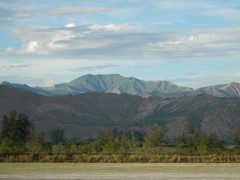
Address: Zambales
Description: In Zambales, the eruption of Mt. Pinatubo in 1991 resulted in the displacement and separation of the Aetas from their ancestral land, depriving them of their lifeblood. Today the spirit of “Kainumayan,” the name by which the Aetas referred to FPE’s enabling and supporting intervention, once again fuels their drive for self-sufficiency and well-being.
Status: Closed
|
Ecosystem Types |
Montane Forest |
|
Area |
41,317 hectares |
|
Biogeographic Highlights |
|
|
Flora |
|
|
Livelihood Resources |
Agriculture, Agroforestry |
|
Indigenous Peoples |
Once the stewards of the mountains of the Zambales range, the Aetas have become hesitant occupants of hastily-built resettlement villages, following the aftermath of the 1991 Mt. Pinatubo eruption. |
and clearing practices, particularly in upland areas, that result in the fragmentation of habitats.
Incidents of wild fires resulting from reckless clearing methods.
Slash-and-burn farming – while sustainable in the past – has become untenable when migrant settlers compete with Aetas for good farming areas. This influences the spread of illegal logging activities.
Mining of talc in the area, coupled with sand and gravel quarrying poses a potential threat.
Poaching of faunal and floral resources, as well as illegal logging and charcoal extraction, reduce the project area’s biodiversity value dramatically.
|
Project |
Grant Type, Strategy |
Duration |
Implementing Partners |
|
Indigenous Knowledge-based Community Planning Activity With the Maporac Aeta Organization In Zambales |
Small, Site-focused, Constituency-building |
2011-2012 |
|
|
Mam-Eh (Sharing) Action Plan for The First Aeta Forest Foods Festival and Develoment Forum |
Small, Advocacy |
Apr-Jul 2011 |
|
|
Byaheng Ayta: Tracing Roots Reaching Hopes |
Medium, Constituency-building |
Feb-Aug 2008 |
|
|
Resource Valuation Training for Mining-Affected Communities |
Small, Constituency-building |
Dec 2008-Mar 2009 |
|
|
A Shift Towards Area-Specific Intervention through Strategic Planning for Six Priority Sites (Zambales) |
Large, Site-focused, Proactive |
2006-2007 |
|
|
Pagsasaayos ng Silid-Aklatang Ayta |
Small |
2005 |
|
|
Integrated Biodiversity Conservation and Sustainable Management of Ancestral Domains Project (IBC-Sumad) or Kainumayan |
Medium to Large, Site-focused |
2001-2004 |
|
|
Zambales Mountain Range Community-Based Resource Management Project |
Small, Site-focused |
2001 |
|
|
Showcasing Aeta Community-based Resource Management Towards Sustainable Development |
Small, Responsive Grant |
1998 |
|
|
Nature Conservation Fund Co-financing |
FPE Special Project |
1997 |
|
|
Community-Based Seed Production and Propagation of Indigenous Agroforestry Species (IAS) |
Responsive Grant |
1993-1995 |
|
|
Nature Awareness Conservation Camp |
Responsive Grant |
1993 |
|
Strengthened four CADC-holding POs, which led to the Pederasyon ng mga Aytang Samahan sa Sambales (PASS).
More than a development project and management scheme, Kainumayan embodied the aspirations of the Aeta people. It is a Sambal term roughly translated as self-sufficiency and well-being not just of the people, but also of the natural environment.
The co-financing and co-management structure of the Kainumayan project helped re-establish a sense of franchise and proprietorship among the Aeta communities, who had previously been displaced by the Pinatubo eruption.
Capacity-building and training on leadership, organizational management, and advocacy.
Assistance in alternative livelihood projects which helped lessen the communities’ impact on the natural resource base.
Strong advocacy and action aligned towards the reclamation of ancestral domain rights for the Aetas, including the drafting and finalization of the Ancestral Domain Sustainable Development Protection Plan (ADSDPP).
PASS has successfully turned over leadership and management of conservation initiatives to the younger generations. Now equipped with their own office, PASS members are also adopting modern technologies and integrating them into their daily lives.
Radyo Ayta initiated.
Establishment of networks and linkages (LGUs, other organizations and institutions).
Advocacy actions have contributed to temporarily stalling the ongoing mining operations in Maporac.
Foundation for the Philippine Environment. 2004. Sustaining Biodiversity Conservation Initiatives: Site Focused Projects 2003. Quezon City, Philippines: Foundation for the Philippine Environment.